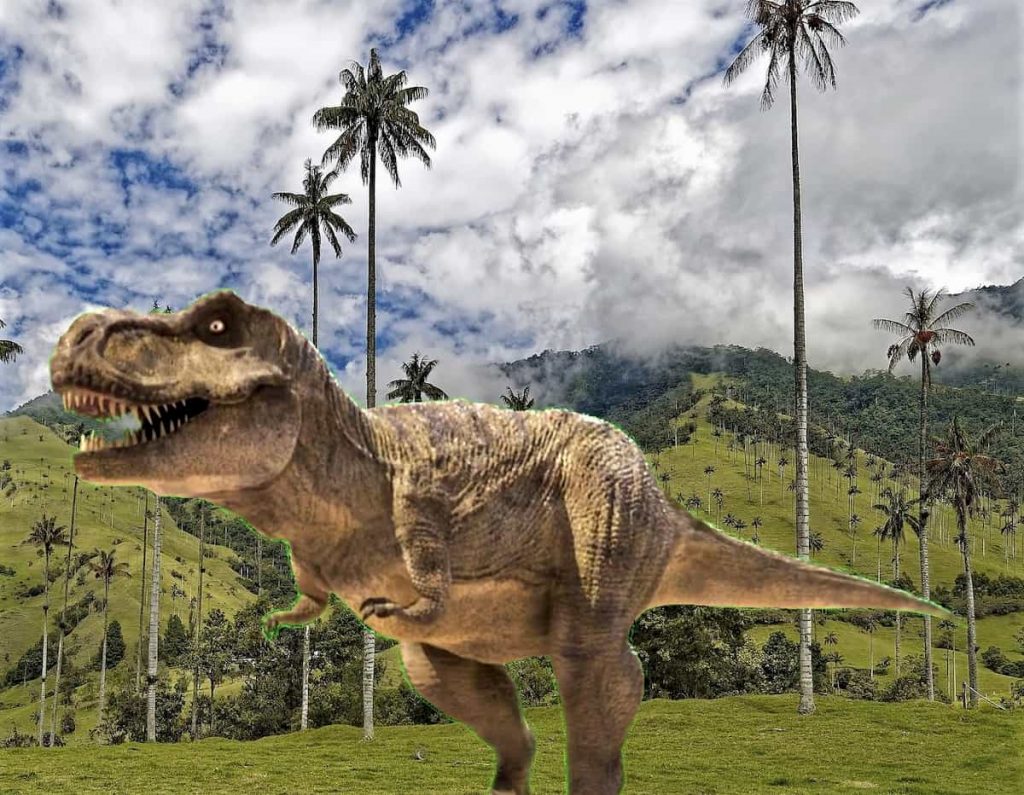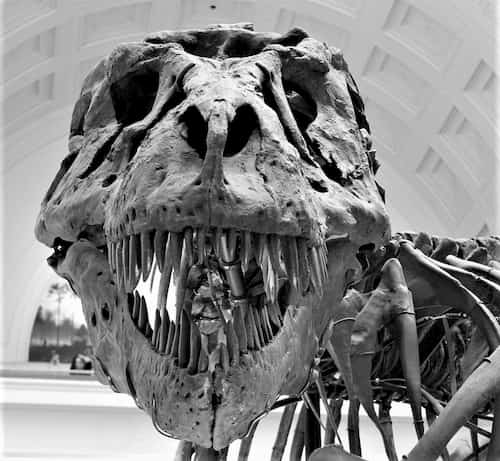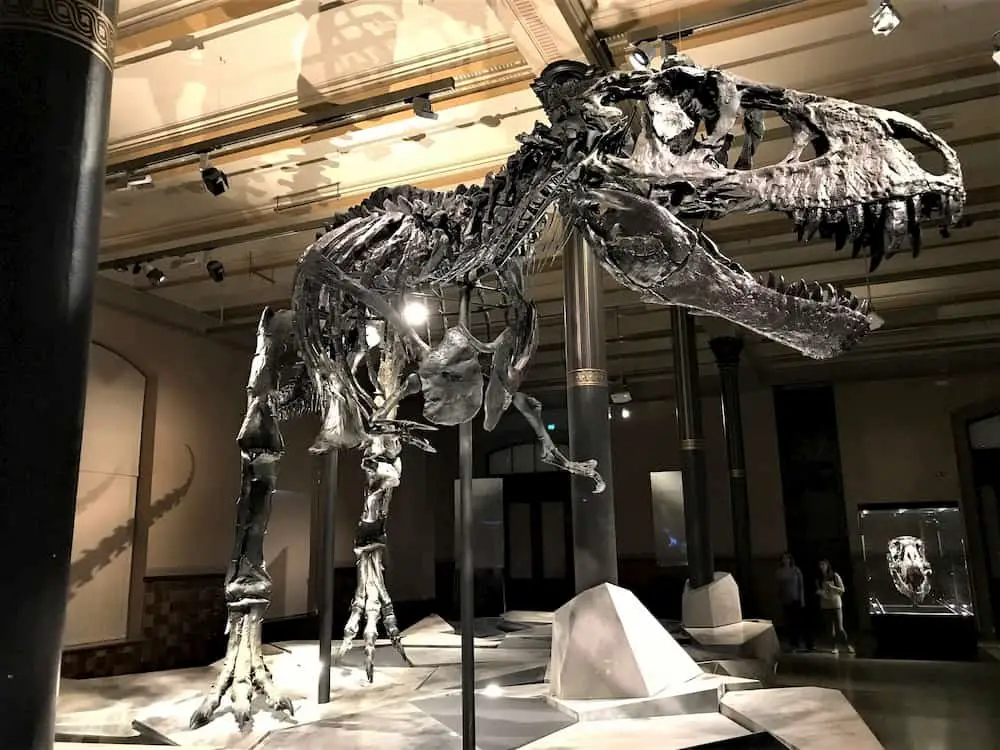Could a normal, healthy, grown man have outrun a Tyrannosaurus Rex?

The Tyrannosaurus Rex… King of kings.
Tyrannosaurus Rex was one of the biggest carnivorous dinosaurs that ever walked on planet earth. Recent discoveries show that it could have reached more than 40 feet (12 meters) in length and weighed almost 10 metric tons. It had enormous, centrally placed back legs but the front legs were very small. Scientists still argue if they were of any use at all. The most probable explanation would be this: As the head, with time, grew bigger and stronger, much of the muscles holding and moving the heavy skull and working the powerful jaws interfered with the upper arm- and shoulder musculature. Natural selection promoted the head over the arms. Much like modern times birds. It was a bite, pull, shake and twist kind of movement. And for that, no arms were needed.
The head was 5 feet (1,5 meters) long with a monstrous mouth full of razor-sharp teeth, which could reach 6 inches (15cm) in length. New computer models show that it had a rigid skull, much like modern days Alligators. This would increase the estimated power of the jaws, and the bite force could have been as much as 60.000 Newton. That’s about four times the saltwater crocodile chomping record of about 16.000 Newton. A T-Rex would have had no problem eating the cars in Jurassic Park. It had the most powerful bite force of any land-living animal ever.
 Where, and when did it live?
Where, and when did it live?
The T-Rex lived in North America, which at the time was cut off from South America and much closer to Europe. It preferably inhabited semi-tropical, open forests or coastal habitats. It fed on big dinosaurs and carcasses. A lot of discussions are going on about if it ate live prey or if it was more of a scavenger. The size and the T-rex’s relatively slow running speed have questioned if it could hunt at all. Nowadays consensus is that it probably did both. Just like any of today’s big predators, it wouldn’t refuse a meal if it was already served.
It lived during the late Cretaceous period, 85 million to 65 million years ago.
It was extinct 65 million years ago when a huge asteroid hit Mexico, the so-called Cretaceous–Paleogene (K-Pg) extinction event. In a very short period, three-quarters of all living species on earth died. All land-living dinosaurs, with the exception of avian species, perished.
But I’ve seen it chase a jeep in the film Jurassic Park…
The truth is that we can’t know everything about the dinosaurs. It’s a guessing game based on fossils and chemical analysis. It is difficult to determine the color for example. We have to try and find substances on and around the fossils and go from there. Lately, it’s been discovered that the gigantic beasts probably had feathers. Not like birds, but still some sort of hairy covering on top of the trunk.
The jeep scene in Jurassic Park is regarded by most scientists today as non-realistic. There’s just no way a T-rex could run that fast. And it probably wouldn’t even try to chase the jeep. The hunting technique wasn’t up for it. It was more of a big elephant than a lion.
 So, how fast can a T-rex run?
So, how fast can a T-rex run?
Recent studies consider not only muscle mass, weight, and size, but also bone resistance for example. The huge muscles would also require anaerobic combustion during acceleration. As it couldn’t keep that up for very long, the time available for reaching top speed was limited. It would also have to use a considerable amount of energy to move all that weight. Put into computer models, all this new data gives that the T-rex could run 15 mph (24 km/h) at most. Steady jogging rather than sprinting.
In fact, among all reptiles, mammals, and sea animals the fastest animals are of small to medium size.
And how fast can an average man run?
The world record for 100 meters is 9,58 set by Usain Bolt in 2009. Calculating the time for acceleration, reaction to the start signal, and slowdown at the end of the track, the top speed during his world record race is 27 mph ( 43,5 km/h). That’s phenomenal. And not everybody can run like that… Nobody can, not anymore.
An average, fit man in his 30s or 40s could do it in 15 seconds. Doing the exact same calculations we end up with a top speed of around 16 mph (26 km/h).
That is actually faster than the T-rex. But, it’s the absolute top speed. He probably wouldn’t be able to keep that up for more than a few seconds. After that, the Dinosaur will gain on him. And the 15 seconds is on an absolutely flat track, In terrain, he would be much slower.

The average man could be faster than this or he could be slower. The T-rex could be old and tired or young and strong. Any way you look at it, it would be a very close shot.
Putting emphasis on the word COULD, then it is possible. Usain Bolt definitely could outrun a T-rex, but any ordinary man could too, even if it would be close.
But if the T-rex run was so slow, how did it catch its prey?
The T-rex runs slowly, and it probably was something of an opportunist, eating what it could find, attacking young or sick animals… Or already dead ones. Its ferociousness and gigantic size put it at the top of the nutrition chain. And there it could eat about anything, as long as it wasn’t too fast or too small.
This is something we can see today as well. The biggest creatures in the sea, the whales, eat plankton. It’s a question of economy. They just wouldn’t be able to eat enough to compensate for the energy they would lose hunting. Not if they went after big, fast, and strong prey. Either you eat a lot, or you consume very little preparing your meal.
The T-rex wasn’t able to run very fast. Maybe it was the maximum possible size of a carnivorous animal on earth. Bigger than that, and you have to eat something that is sitting still… Like grass.
What else should you do if you were unfortunate enough to encounter one?
The other idea of Jurassic Park, that you should stand still, is also wrong. The T-rex had huge eyes facing partially forward. It could probably spot a man from miles away… And it could probably determine the distance at least as well as we can. It would have no problem finding you even if you stood absolutely immobile.
Running away would still be your best option. If you could find dense vegetation somewhere, that would be the place to go.
The T-rex would run with 10 tons of weight on its shoulders.
It wouldn’t be agile. So you could try the old Rhinoceros trick. Stay put, until he’s a few meters away. Then run at a 90° angle to the right or to the left. The Tyrannosaurus would probably continue straight ahead for a bit before he could turn. You would need nerves of steel for that though….
Maybe it’s still better to head for the bush…
Conclusion
Yes, a normal, healthy, fit man could have outrun a Tyrannosaurus Rex, even if it would have been a very close shave.

sources
- The Telegraph / T Rex could not have outrun a speedy human, scientists conclude
- National Geographic
- Business Insider / The T. Rex had the strongest bite of any land animal ever
- Gizmodo / What Did T. Rex Look Like? A New Exhibit Has the ‘Ultimate Predator’ in Feathers
- American Museum of Natural History / Tyrannosaurus Rex
- Data Genetics / World’s Fastest Man